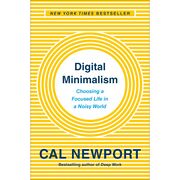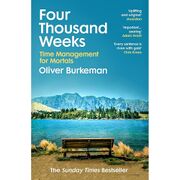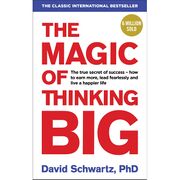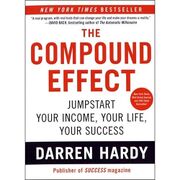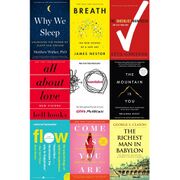The One Thing
🍎 Healthy brain food
"Success is built sequentially. It’s one thing at a time."
— Gary Keller; Jay Papasan, The ONE Thing (2013)
Introduction
| The One Thing | |
|---|---|
 | |
| Full title | The ONE Thing: The Surprisingly Simple Truth Behind Extraordinary Results |
| Author | Gary Keller; Jay Papasan |
| Language | English |
| Subject | Productivity; Time management; Personal development |
| Genre | Nonfiction; Self-help |
| Publisher | Bard Press |
Publication date | 1 April 2013 |
| Publication place | United States |
| Media type | Print (hardcover, paperback); e-book; audiobook |
| Pages | 240 |
| ISBN | 978-1-885167-77-4 |
| Goodreads rating | 4.1/5 (as of 6 November 2025) |
| Website | the1thing.com |
📘 The ONE Thing is a 2013 self-help book by Gary Keller and Jay Papasan, published by Bard Press, which argues that extraordinary results come from concentrating on a single priority. [1] It centers on a single tool—the Focusing Question, “What’s the ONE Thing I can do such that by doing it everything else will be easier or unnecessary?”—and on time blocking as the daily practice that makes that focus real. [2] The book is arranged in three parts (“The Lies,” “The Truth,” and “Extraordinary Results”) in brief chapters that end with “Big Ideas” recaps and a direct, coaching register. [2] Trade reviewers described the prose as energetic and prescriptive—Publishers Weekly praised its “appealing style and energy” while noting its coach’s verve. [1] The title debuted strongly: the authors’ company reported it reached #1 on the Wall Street Journal business list, #2 on the New York Times Advice/How-To list, and sold more than 60,000 copies in its first month in May 2013. [3]
Chapter summary
This outline follows the Bard Press hardcover first edition (1 April 2013; 240 pp.; ISBN 978-1-885167-77-4).[4][2]
🎯 1 – The ONE Thing. On 7 June 1991, the comedy film City Slickers put a crisp idea on the screen when Jack Palance’s trail boss Curly held up one finger and told Billy Crystal’s Mitch that life turns on “one thing.” In the years that followed I hit a wall running Keller Williams and asked a coach to unpack the work. He mapped the org chart and concluded that 14 key seats needed new people. I stepped down as CEO and made hiring those 14 my singular mission. Within three years the company began a nearly decade-long run averaging about 40 percent growth year over year, shifting from a regional player to an international contender. Coaching my top people, I saw long task lists produce motion without results, so I kept shrinking them until a single priority stood front and center each week. The language of the The ONE Thing emerged from that practice and from a simple, repeatable question that made every next action obvious. I call the approach “going small,” a bias toward the essential that trades breadth for progress. The lesson is that focus converts effort into traction. Narrowing attention reduces decision friction and channels limited time and energy into the one action most likely to move everything else. The way to get the most out of your work and your life is to go as small as possible.
🧩 2 – The Domino Effect. In Leeuwarden, Netherlands, on Domino Day, 13 November 2009, Weijers Domino Productions set more than 4,491,863 dominoes and released over 94,000 joules—about the energy of 545 push-ups—from a single tap. In 1983, University of British Columbia physicist Lorne Whitehead showed that one domino can topple another 50 percent larger, turning a line into a geometric progression. In 2001, San Francisco’s Exploratorium built eight plywood dominoes from two inches to nearly three feet tall; the chain began with a soft tick and ended with a loud slam. Extrapolated, the 10th domino reaches Peyton Manning’s height, the 18th rivals the Leaning Tower of Pisa, the 23rd clears the Eiffel Tower, the 31st rises more than 3,000 feet above Everest, and the 57th spans the distance from Earth toward the moon. The physics is simple: line up potential energy, then tip the lead piece to unlock outsized force. In life, priorities rarely arrive prearranged, so array them daily, find the lead domino, and keep striking it until it falls. Small wins then compound into breakthroughs. Extraordinary results come from sequential focus, not simultaneous effort; when the right first action falls, the rest becomes easier or unnecessary. Success is built sequentially.
👣 3 – Success Leaves Clues. Extraordinary enterprises tend to be known for one thing. KFC began with one guarded chicken recipe. Adolph Coors grew roughly 1,500 percent from 1947 to 1967 on a single beer brewed in one plant. Intel’s revenue is driven largely by microprocessors. Google’s search enables its ad engine. In the Star Wars universe, merchandise revenue has surpassed box office for early films. Apple shows how a company can transition its ONE Thing over time—from Macs to iMacs to iTunes to iPods to iPhones (with iPad waiting in the wings)—while the flagship casts a halo that lifts the line. The pattern holds for people: Walt Disney had Roy Disney opening doors; Sam Walton relied early on L. S. Robson; Albert Einstein benefited from mentor Max Talmud; Oprah Winfrey credits her father and adviser Jeffrey D. Jacobs; the Beatles’ studio sound was shaped by producer George Martin. One passion can mature into one signature skill. Concentration organizes resources, attracts allies, and creates a flywheel where mastery, results, and reputation reinforce one another. If today your company doesn’t know what its ONE Thing is, then the company’s ONE Thing is to find out.
I – The Lies: They Mislead and Derail Us
⚖️ 4 – Everything Matters Equally. In the late 1930s at General Motors, managers discovered that a card reader feeding early computing gear was spitting out gibberish. A visiting Western Electric consultant, Joseph M. Juran, took the challenge home, cracked the cipher by three o’clock the next morning, and later used the insight to separate the “vital few” from the “useful many.” That story sets up Pareto’s Principle: a minority of inputs drives a majority of outcomes. Left raw, to-do lists become survival lists that reward noise over impact; achievers convert them into short “success lists” by ranking tasks against results. Equality is a worthy social ideal but a poor lens for decisions—work isn’t equal, and neither are tasks on a page. A to-do list becomes a success list when you apply Pareto’s Principle to it.
🔀 5 – Multitasking. In 2009 at Stanford University, Clifford Nass tested 262 students, sorted them by media multitasking, and expected the heavy multitaskers to excel; instead, they proved most distractible across measures. “Multitasking” began as a 1960s computer term for time-sharing a CPU, not for humans doing two complex things at once. Switching carries reorientation costs that can chew up a quarter of a workday. Juggling looks simultaneous, but it is rapid alternation. You can do two things at once, but you can’t focus effectively on two things at once.
🧗 6 – A Disciplined Life. Michael Phelps illustrates “selected discipline.” Diagnosed with ADHD, he trained daily under Bob Bowman for years; the haul by London 2012—22 medals, 18 golds—shows what one habit can yield. Use short bursts of discipline to install a routine, then let habit carry the load. Studies suggest new behaviors reach automaticity around 66 days on average; keystone habits can spill over into others. Success is actually a short race—a sprint fueled by discipline just long enough for habit to take over.
🪫 7 – Willpower Is Always on Will-Call. A 10-month analysis of 1,112 Israeli parole decisions showed approvals peaking just after breaks and plunging before them, a portrait of decision fatigue. Because willpower fluctuates, block mornings for your ONE Thing and keep the tank filled so default choices don’t dictate the day. Willpower isn’t on will-call.
🧘 8 – A Balanced Life. Balance is a mirage; real life is continuous counterbalancing. Go long on the few things that matter at work and short in personal life so family, health, and relationships aren’t neglected. An extraordinary life is a counterbalancing act.
🗻 9 – Big Is Bad. “Megaphobia”—fear of big—shrinks ambition. Think big to design the right box for your future; a growth mindset changes effort, strategies, and resilience. Don’t let small thinking cut your life down to size.
II – The Truth: The Simple Path to Productivity
❓ 10 – The Focusing Question. One prompt serves as map and compass: What’s the ONE Thing I can do such that by doing it everything else will be easier or unnecessary? Use it at big-picture and right-now scales across life domains to reveal the lead domino.
🔁 11 – The Success Habit. Turn the question into a daily loop—on waking, on arriving at work, and at home—until it becomes automatic. Cues and repetition make the best action rise by default.
🛣️ 12 – The Path to Great Answers. Ask a great question, then pursue a great answer. Favor “big and specific,” research best practices, and run focused experiments until a better answer appears.
III – Extraordinary Results: Unlocking the Possibilities Within You
🧭 13 – Live with Purpose. Purpose clarifies choices and sustains effort. When direction and action match, behavior hums; meaning amplifies motivation across long horizons.
🔝 14 – Live by Priority. Use “Goal Setting to the Now” to nest someday, five-year, one-year, monthly, weekly, daily, and “right now” targets, translating purpose into a single present priority.
⚙️ 15 – Live for Productivity. Time block your ONE Thing early and in big chunks. Build a bunker, protect the block, and if you erase it, replace it immediately.
🤝 16 – The Three Commitments. Pursue mastery, shift from doing what’s natural to what’s purposeful (models, systems, coaching), and live with accountability so the right behaviors compound.
🦹 17 – The Four Thieves. Guard against saying yes to everything, fear of chaos, poor energy habits, and unsupportive environments. Protect attention so your priority can happen on time.
🛤️ 18 – The Journey. Think as big as possible, then go small. Feed the right “inner wolf,” align person and plan, and let sequential focus compound.
Background & reception
🖋️ Author & writing. Gary Keller is the co-founder and executive chairman of Keller Williams Realty; Jay Papasan is a senior content leader at the company. [5][6] Before this book, Keller’s business writing included the national-bestselling The Millionaire Real Estate Agent (2004), positioning the new title as a general-audience guide rather than a real-estate manual. [7] Keller has said the core idea arose from years of coaching when he shortened long task lists to one “Focusing Question.” [2] A contemporaneous interview summarized the approach as prioritization plus distraction management. [8] Reviewers also noted the coach-like tone. [1]
📈 Commercial reception. Keller Williams reported that, as of 4 May 2013, the book had reached #1 on the Wall Street Journal business list, #2 on the New York Times Advice/How-To list, and sold more than 60,000 copies in its first month. [3] WSJ also listed the title on its combined best-seller chart for the week ended 28 April 2013. [9]
👍 Praise. Publishers Weekly highlighted the book’s “appealing style and energy.” [1] The National called it a practical guide that “banishes multitasking and to-do lists to the bin,” foregrounding focus on the most important task. [10] Quartz (via Yahoo syndication) likewise underscored the core claim that highly successful people are known for “one thing.” [11]
👎 Criticism. *Kirkus Reviews* judged that the book offers “encouraging bones of advice worth gnawing on” but is “absent substantial meat,” arguing it skirts specifics. [12] *Publishers Weekly* similarly wrote that, despite its energy, “more intellectual substance would have helped.” [1]
🌍 Impact & adoption. By May 2013 the authors had toured North America with a half-day seminar based on the book, reaching thousands of business leaders. [3] The title’s concepts have been included in corporate learning libraries via services such as GetAbstract. [13] Public-sector and nonprofit teams have circulated one-page guides for staff training—for example, a Texas statewide program distributed a summary of the book’s core ideas for team use. [14]
Related content & more
YouTube videos
CapSach articles
Enjoyed this page?
📚If this page The One Thing inspired or helped you today, a small coffee helps us keep creating and sharing more. Your support truly matters.👏
References
- ↑ 1.0 1.1 1.2 1.3 1.4 "The One Thing: The Surprisingly Simple Truth Behind Extraordinary Results". Publishers Weekly. PWxyz, LLC. 25 February 2013. Retrieved 6 November 2025.
- ↑ 2.0 2.1 2.2 2.3 "The ONE Thing (front matter and sample chapters)" (PDF). Internet Archive. Bard Press. 2013. Retrieved 6 November 2025.
- ↑ 3.0 3.1 3.2 "Keller Williams Realty Founder Hits #1 on Wall Street Journal Bestseller List". Keller Williams Realty. Keller Williams Realty, LLC. 4 May 2013. Retrieved 6 November 2025.
- ↑ "The one thing : the surprisingly simple truth behind extraordinary results (1st ed.)". WorldCat. OCLC. Retrieved 6 November 2025.
- ↑ "Gary Keller". Keller Williams Realty International. Keller Williams Realty, LLC. Retrieved 6 November 2025.
- ↑ "About Jay Papasan". JayPapasan.com. Jay Papasan. Retrieved 6 November 2025.
- ↑ "Our Story". Keller Williams. Keller Williams Realty, LLC. Retrieved 6 November 2025.
- ↑ "Gary Keller: How To Find Your One Thing". Forbes. Forbes Media. 23 May 2013. Retrieved 6 November 2025.
- ↑ "Best-Selling Books, Week Ended April 28". The Wall Street Journal. 3 May 2013. Retrieved 6 November 2025.
- ↑ Haine, Alice (24 July 2013). "Actions speak louder than to-do lists". The National. Abu Dhabi Media. Retrieved 6 November 2025.
- ↑ "Forget the long to-do lists and choose one thing to be good at". Yahoo (syndicated from Quartz). Yahoo. 19 April 2013. Retrieved 6 November 2025.
- ↑ "THE ONE THING". Kirkus Reviews. Kirkus Media. 15 March 2013. Retrieved 6 November 2025.
- ↑ "The ONE Thing". GetAbstract. GetAbstract AG. Retrieved 6 November 2025.
- ↑ "The ONE Thing — Summary of Concepts" (PDF). Achieving Together (Texas). Texas Department of State Health Services partners. Retrieved 6 November 2025.

